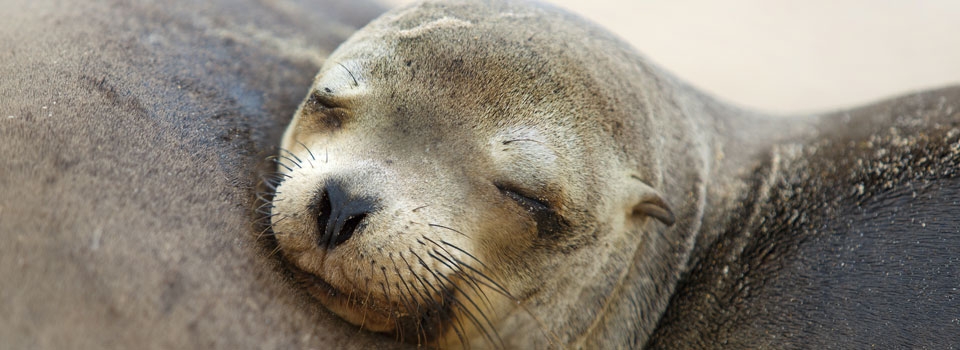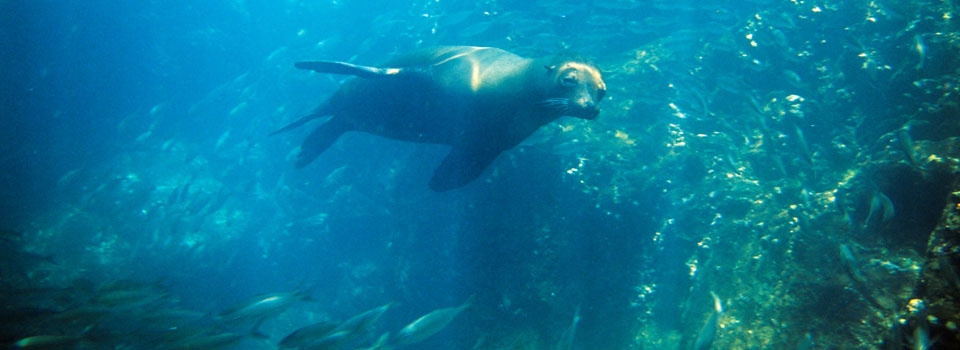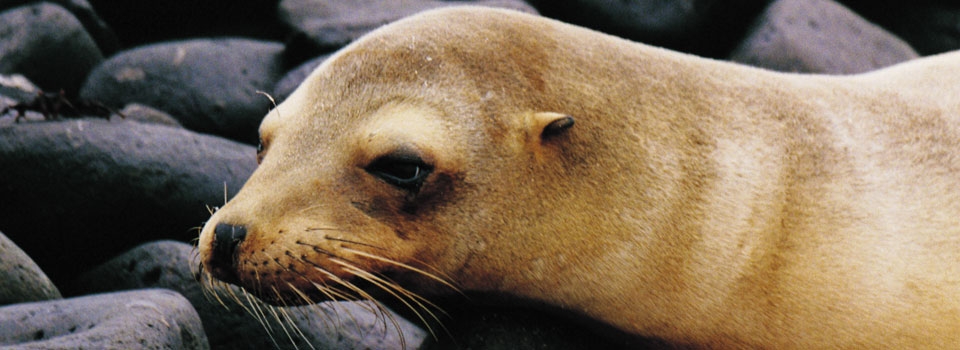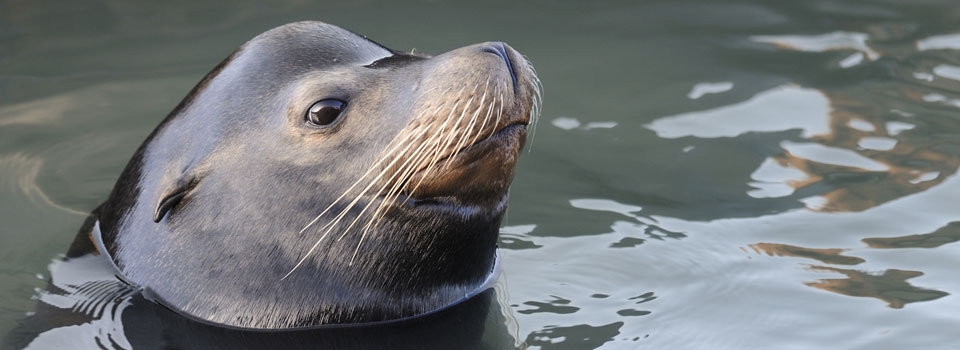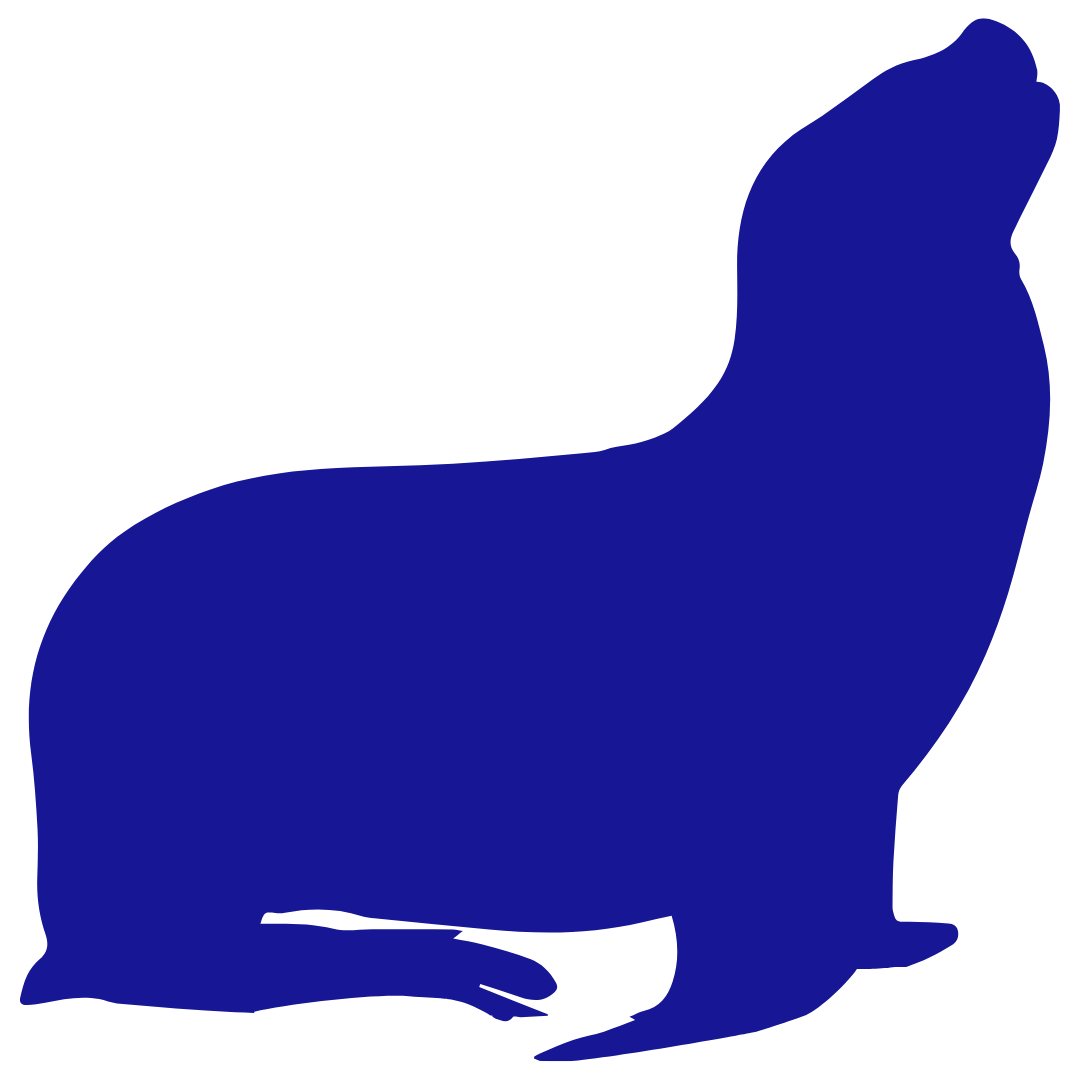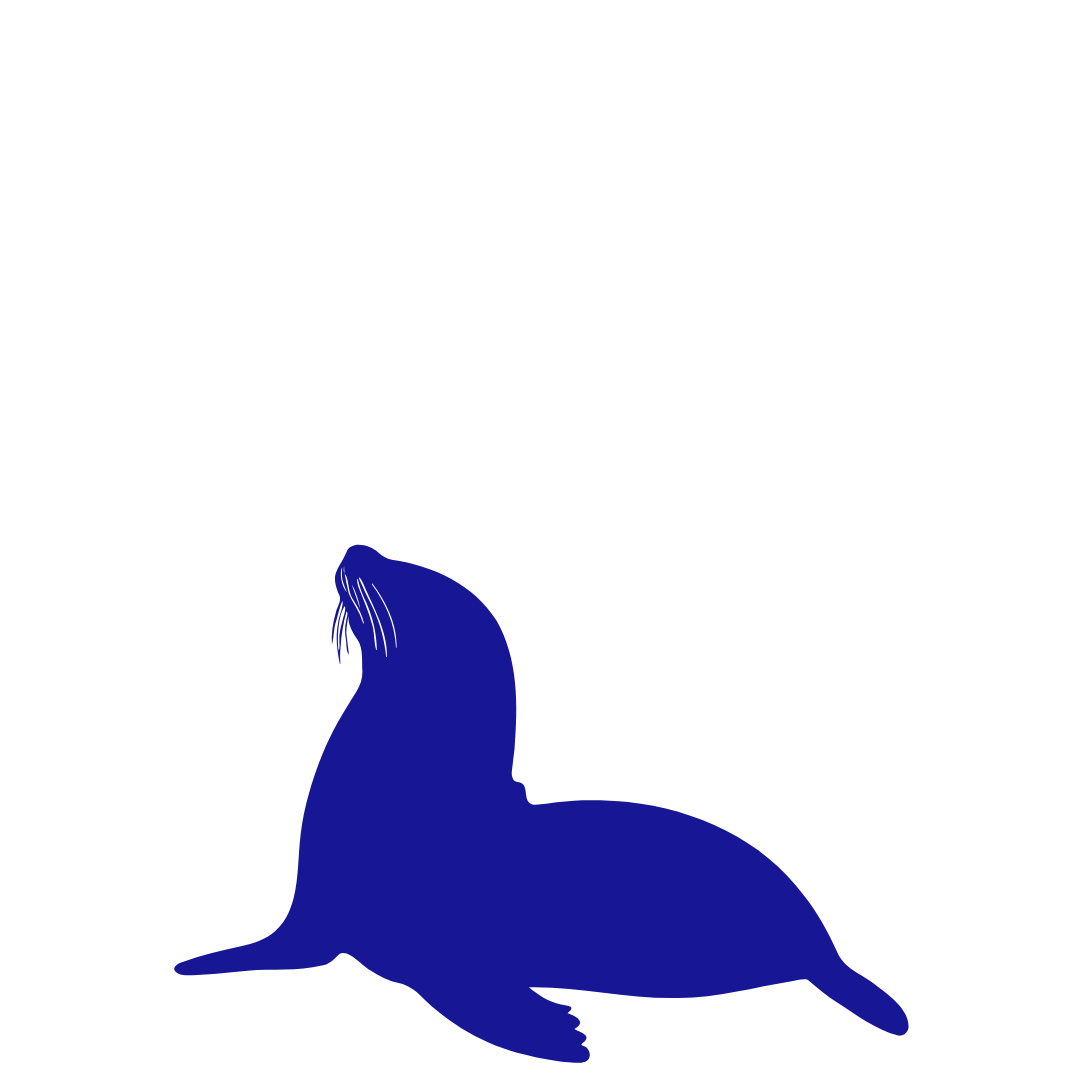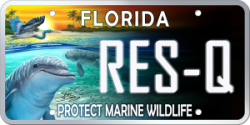California Sea Lions:
| Quick Facts |
|
Average lifespan: 20 years Swim speed: up to 25 mph Typical diet: fish, squid, octopus Range: Vancouver to Mexico |
Facts, Behavior, and Care
Discover the facinating world of these agile and social marine mammals
There are 33 species of pinnipeds (meaning "wing-" or "fin-footed") which include 18 true seals, 14 eared seals (sea lions and fur seals), and 1 walrus. California sea lions belong to the family Otariidae which means "little ears.” In the scientific community, there are many debates concerning the ancestry of eared and true seals. Some scientists believe that eared seals and walruses may have evolved 30 million years ago from bear-like creatures in the North Pacific, and that seals evolved from otter-like carnivores in the North Atlantic.
|
Males 600-800 lbs (270 - 360 kg) 6.5-8 ft (2 - 2.4 m) long |
Females 200-400 lbs (90 - 180 kg) 5-6.5 ft (1.5 - 2 m) long |
Pups 13 lbs (6 kg) 2.5 feet (75 cm) long |
Behavior and Abilities
How fast can a sea lion swim?
Sea lions can swim in burst speeds up to 25 mph, but generally cruise at approximately 11 mph. Sea lions gain speed by porpoising, gliding on the water's surface to minimize resistance. Surfing in front of waves or large whales seems to be a fun activity for sea lions. Sea lions have often been called the “Angels of the Sea” due to the unique way that they swim. Sea lions will use their hind flippers to steer and swim using their front flippers. True seals usually swim at about 6 mph and can reach speeds as fast as 18 mph. Walruses tend to take a relaxing approach to the water, averaging speeds of 6 mph or less.
Do sea lions have good senses?
Hearing: Sea lions hear both above and below the water's surface, although they hear better under water. Studies show sea lions can hear frequencies up to 70,000 Hz, but tend to vocalize within a range of 100 to 10,000 Hz. This is comparable to humans who have a hearing range of 20 to 20,000 Hz. Sea lion vocalizations include barks, clicks, moans, chirps, growls, and squeaks. There is no concrete evidence to suggest that sea lions use echolocation.
Sight: Sea lions, like many marine mammals, can see well both above and below the surface of the water. Unlike humans, sea lions may not see in color. They can possibly discriminate colors in the blue - green spectrum. All pinnipeds have a membrane at the back of each eye called a tapetum lucidum to aid in night vision. Cats also have a tapetum lucidum, which is why the eyes of both cats and sea lions glow at night. On land, their eyes are protected by a nictitating membrane, which wipes away sand and debris.
Smell: Sea lions cannot smell underwater but, above water, smell is a highly developed sense. Females use smell for pup recognition and males use it for breeding purposes to locate females in estrus.
Taste: Sea lions have a limited sense of taste, similar to other marine mammals.
Touch: Sea lions are tactile mammals. Their whiskers contain nerve fibers, which make them sensitive. They may use their whiskers to aid in navigation or to detect vibrations from prey in the water.
What Do Sea Lions Eat? |
Lifespan, Health, and Care |
||
|
|
||
|
|
||
|
|
||
|
|
How do sea lions sleep?
On land, sea lions will sleep in a variety of positions, often on top of their friends. California sea lions have been seen interacting with other species of pinnipeds, such as northern elephant seals, harbor seals, Northern fur seals, and Steller sea lions. In the water, they will sink to the bottom of shallow areas, and occasionally rise to the surface for air. In deeper water, they will float upright with the tip of their nose out of the water.
How do sea lions regulate their body temperature?
Sea lions have the ability to regulate their own body temperature. They can often be seen floating with one flipper out of the water. The reason for this is because the capillaries are close to the surface of the skin and can catch sunbeams to warm their body. To cool down, they put their flipper into the water then raise it back up into the air which cools them off during the evaporation process. This process is called thermoregulation..
Do sea lions molt?
Sea lions molt once each year, usually after the breeding season, but not as obviously as true seals. Molting is when an animal loses its fur or feathers and the coat is replaced with a new one. During the molting season, seals cannot enter the water because they do not have proper insulation to keep them warm. Therefore, they fast during this time period. Sea lions are able to enter the water during their gradual molting period. Sea lion pups will molt twice during their first six months of life. Have you ever touched a sea lion? They are soft and, when wet, feel like a dog that just went swimming.
How do sea lions scratch?
Sea lions actually have three toe nails on each hind flipper. Because sea lions are so flexible, they can reach almost all their possible itchy spots. Sometimes they rub against rocks or other sea lions. Seals have nails on both their front and hind flippers.
How large are sea lions?
Females tend to average between 200 and 400 pounds (90 - 180 kg) in weight, with a length between 5 and 6.5 feet (1.5 - 2 m). Pups only weigh about 13 pounds (6 kg) and are 2.5 feet (75 cm) long when born. Males tend to be larger, weighing about 600 to 800 pounds (270 - 360 kg), with a length of 6.5 to 8 feet (2 - 2.4 m). There are records of adult male sea lions reaching 1,000 pounds! Their cousin, the walrus, makes California sea lions look small. Walruses may weigh more than 3,500 pounds (1,600 kg). Wow, that sure is big!
How long can a sea lion hold its breath?
Sea lions can remain underwater for an average of 8 to 20 minutes. Unlike dolphins, sea lions exhale before diving. Naturally, their nostrils are closed, but they have special muscles to open them in order to breathe. Sea lions can dive to depths between 450 and 900 feet (135 - 272 m). The reason they can dive so deeply and stay underwater so long is because they have a high tolerance for carbon dioxide. The oxygen in their body concentrates in their heart and central nervous system rather than in non-vital organs. Their relative, the elephant seal, can hold its breath for 62 minutes and dive to depths of 4,100 feet (1240 m).
Do the sea lions at DRC take vitamins?
Both of DRC’s sea lions take vitamins orally each day. The fish they receive are flash-frozen from the north Atlantic and lose nutrients during the freezing process. To compensate, the sea lions’ fish diet is supplemented with vitamins such as B Complex and C Plus. Just like dogs, DRC’s sea lions also receive Nemacide, a medication to prevent heartworms. Being in and out of the water makes sea lions susceptible to a variety of internal parasites. This is also a concern for wild sea lions.
Do California sea lions have predators?
Great white, hammerhead and blue sharks, as well as killer whales, occasionally hunt sea lions. Young sea lions are often vulnerable to predation due to unfamiliarity with their new water environment. Water pollution, as well as marine debris such as fishing line, also endangers our friends of the sea. Ropes can tangle around the necks of marine mammals and cut into their skin, blocking the passage for food and eventually resulting in starvation. During the late 1800s and early 1900s, sea lions were hunted and harvested for their blubber and fur. Sea lions are now protected under the Marine Mammal Protection Act of 1972.
Breeding
Once a sea lion becomes sexually mature, at around age four or five, they are able to breed. Female sea lions are called cows, while males are called bulls. Those who live in Baja, California and southern California establish breeding territories from May through July. Cows congregate in closely packed, moderate to large groups. Bulls defend territories and fast during the breeding season.
Males compete for dominance, leaving the younger males without a chance to mate for the season. One distinct characteristic of a full-grown breeding male is the presence of a sagittal crest, a raised forehead that appears at about 10 years of age. The dominant male will mate with an average of 16 females in one season. Once the egg is fertilized inside the female, she can delay implantation of the egg to stop the embryo from growing. The delayed implantation may last up to three months with an average gestation period lasting 9 months. Sea lions mate approximately 20 - 30 days after the birth of their pup, leaving only about one month out of the entire year that she is not pregnant.
In the Northern Hemisphere, pups tend to be born in mid-June. Each mother usually gives birth to a single pup. Twins are rare and mothers seldom adopt other pups. The pup nurses from the mother's four abdominal teats for about 6 - 12 months. The length of lactation increases with the increasing age of the female. Sea lion milk contains about 35% fat so the pups grow rapidly. Pups begin feeding on fish along with the mother's milk after about two months. Between nursings the mother returns to the sea and feeds for several days, leaving her pup on the mainland. Upon her return, she recognizes her pup on land through vocalizations and/or scent. Once the mating season is over, the males seasonally migrate long distances north while the females do not move beyond the Southern California Channel Islands. The males return to the breeding grounds from March to May.
For additional great information about California sea lions, check out the Alliance of Marine Mammal Parks & Aquariums (AMMPA) species fact sheet. Available in English, Spanish, and Portugese.
REFERENCES:
Bonner, W. Nigel. 1990. The Natural History of Seals. Facts on File Publications, New York, NY.
Fay, Francis H. 1982. Ecology and Biology of the Pacific Walrus, Odobenus rosmarus divergens
Illiger. North American Fauna 74. Wahington, D.C.: U.S. Department of the Interior, Fish and Wildlife Service.
Gentry, Roger L. "Seals and Their Kin." National Geographic 171(4), April 1987, pp. 475-501.
Goodridge, Harry, and Lew Dietz. 1974. A Seal Called Andre. Down East Books, Camden, E.
Hanggi, Evelyn B. "The Importance of Vocal Cues in Mother-Pup Recognition in a California Sea Lion." Marine Mammal Science 8(4), 1992, pp. 430-432.
Harrison, R.J., Richard C. Hubbard, Richard S. Peterson, Charles E. Rice, and Ronald J. Schusterman, eds. 1968. The Behavior and Physiology of Pinnipeds. Meredith Corp., New York, NY.
Leon, Vicki. 1988. Seals and Sea Lions; An Affectionate Portrait. Blake Publishing, Inc., San Luis Obispo, CA.
King, Judith E. 1983.Seals of the World. Second edition. Comstock Publishing Associates, New York, NY.
Patent, Dorthy Hinshaw. 1990. Seals, Sea Lions and Walruses. Holiday House, New York, NY.
Peterson, Richard S. and George A. Bartholomew. 1967. The Natural History and Behavior of the California Sea Lion. The American Society of Mammologists, Stillwater, OK.
Reeves, Randall R., Brent S. Stewart, and Stephen Leathwood. 1992. The Sierra Club Handbook of Seals and Sirenians. Sierra Club Books, San Francisco, CA.
Renouf, Deane, ed. 1991. The Behavior of Pinnipeds. Chapman and Hall, New York, NY.
Ridgway, Sam H. and Richard J. Harrison F.R.S., eds. 1981. Handbook of Marine Mammals.
Volume 1: The Walrus, Sea Lions, Fur Seals, and Sea Otter. Academic Press, New York, NY.
Ridgway, Sam H. and Richard J. Harrison F.R.S., eds. Handbook of Marine Mammals. Volume 2: Seals. Academic Press, New York, NY.
Riedman, Marianne. 1990. The Pinnipeds: Seals, Sea Lions, and Walruses. University of California Press, Berkeley, CA.
Scheffer, Victor B. 1958. Seals, Sea Lions, and Walruses, a Review of the Pinnipedia. Stanford University Press, Stanford.
Stewart, B.S. and P.K. Yochem. 1986. "Size, Status, and Demography of Pinniped Populations in the Southern California Bight. "Hubbs Marine Research Institute Technical Report No. 86-195.
Stuart, Frank S. 1954. A Seal’s World. Pyramid Publications, Inc., New York, NY.

